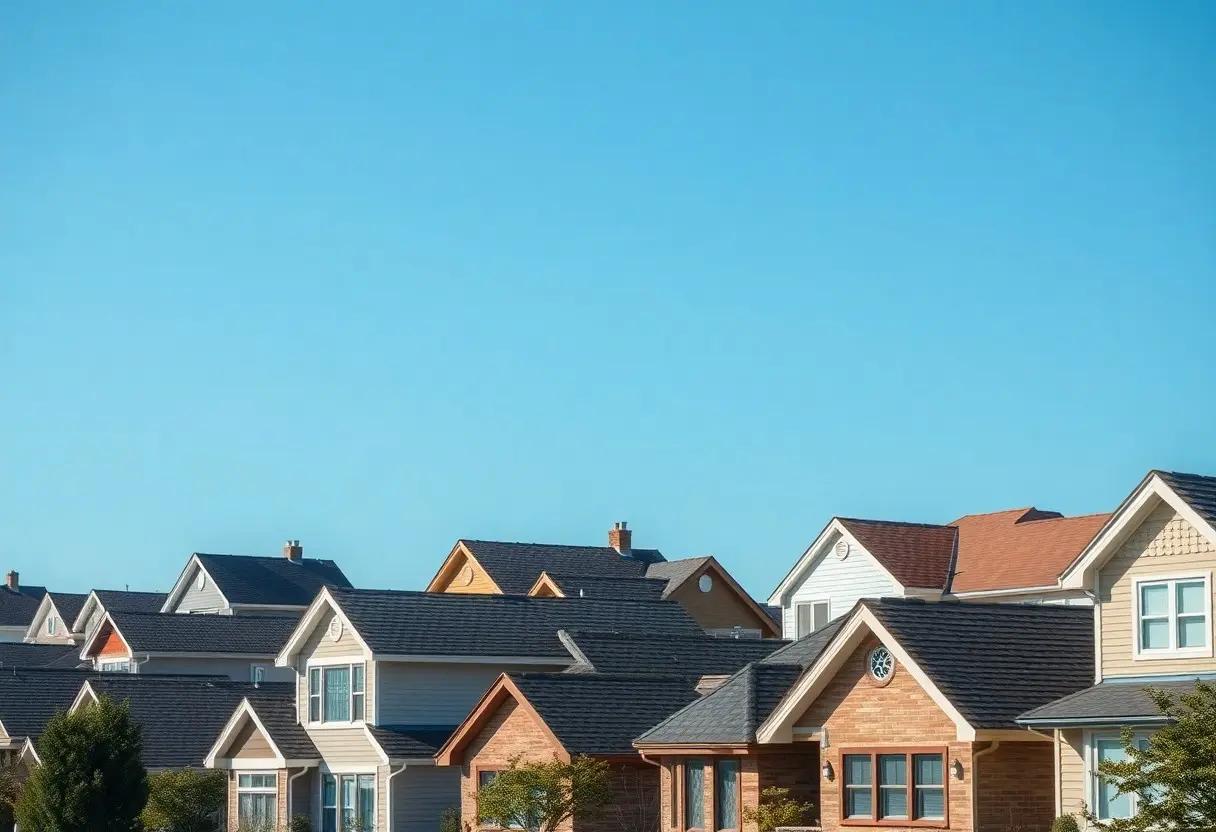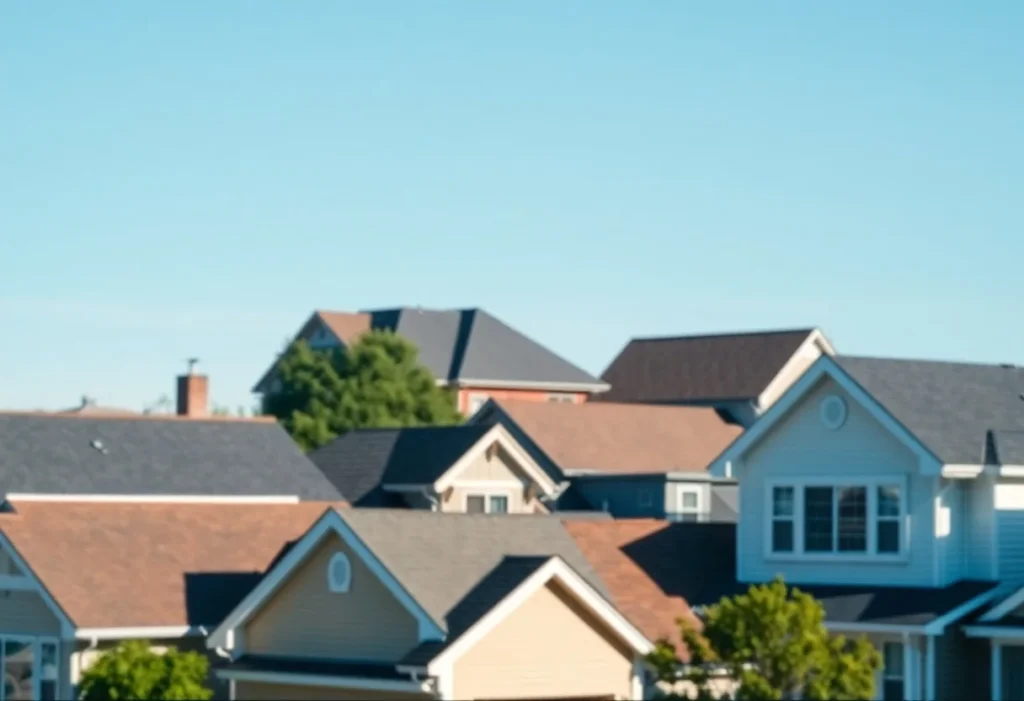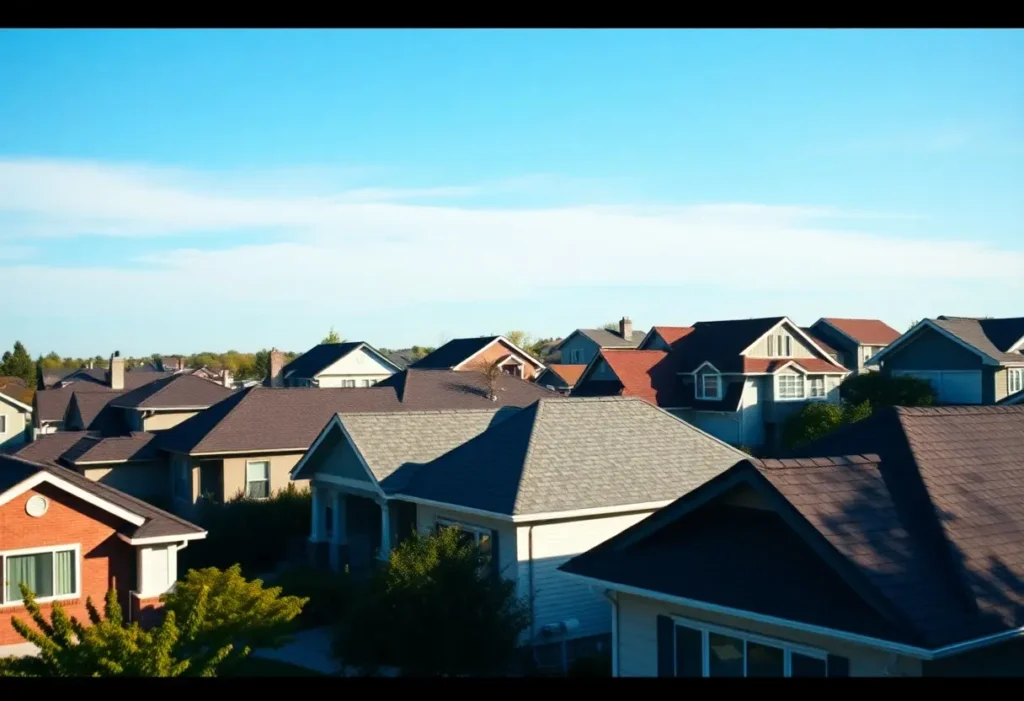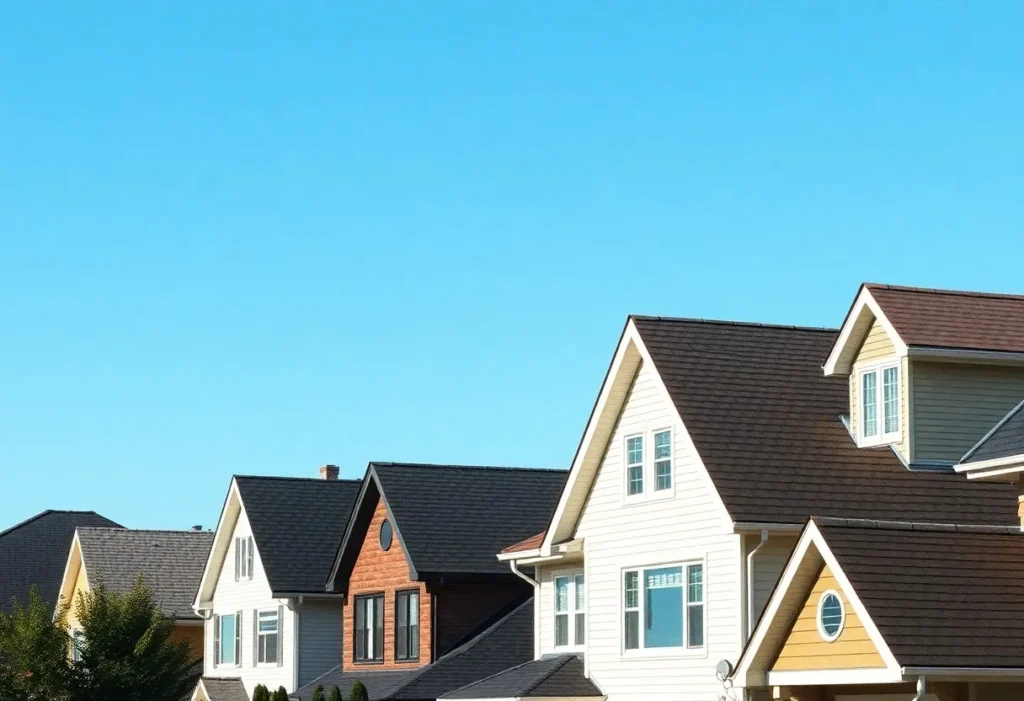What Is the Average Roof Slope for Residential Homes?

There’s a lot to consider when it comes to your home’s roof, particularly its slope. Understanding the average roof slope for residential homes is necessary as it directly impacts drainage, snow accumulation, and the overall appearance of your property. Typically, the average roof slope ranges between 4:12 to 9:12, meaning for every 12 horizontal inches, your roof rises between 4 to 9 inches. Knowing this will help you make informed decisions about maintenance, repairs, or even new construction, ensuring your home remains safe and visually appealing.
Key Takeaways:
- The average roof slope for residential homes typically ranges from 4/12 to 8/12, meaning for every 12 horizontal inches, there is a rise of 4 to 8 inches.
- Roof slope, also known as pitch, affects water drainage, snow accumulation, and overall aesthetics of the home.
- Different regions may have varying average roof slopes based on local weather conditions and building codes.
- Low-slope roofs (less than 4/12) are often used for modern styles, while steeper slopes are more traditional and can prevent water pooling.
- Homeowners should consider not only the aesthetic appeal but also practical considerations, such as maintenance and insulation, when choosing roof slope.
Decoding Roof Slope: What Does It Mean?
The Basics of Slope Measurements
Slope measurements indicate the steepness or angle of your roof, typically expressed as a ratio of vertical rise to horizontal run. For example, a slope of 4/12 means that for every 12 horizontal inches, the roof rises 4 inches. This ratio is significant, as it influences both water drainage and the types of roofing materials suitable for your home. Generally, a steeper roof, such as an 8/12 pitch, can shed water and snow more efficiently, while lower slopes can present challenges in preventing water pooling.
In some regions, local building codes may dictate specific slope requirements, especially in areas with heavy rainfall or snowfall. Following these guidelines not only enhances the performance of your roofing system but also helps ensure safety. Ensuring your roof meets these standards can play a significant role in avoiding leaks and other structural problems down the line.
Reading Roof Pitch: A Closer Look
Determining the roof pitch involves assessing the height of the roof against its width. A simple tool such as a level and measuring tape can help you accurately calculate this. The rise-over-run ratio is particularly beneficial for visualizing how sharply your roof ascends. Steeper pitches not only affect aesthetics but also impact energy efficiency; for instance, a higher pitch can improve airflow in your attic space. This, in turn, may enhance your HVAC system’s performance and longevity.
Familiarity with your roof’s pitch allows you to make informed decisions regarding repairs and maintenance. Many homeowners often overlook the importance of the angle during renovations. If you’re considering a replacement or enhancement, understanding how the pitch interacts with insulation levels and roofing material types can increase the lifespan of your roof. Selecting appropriate materials becomes important, as not all options perform equally well with varying pitches.
Calculating Average Roof Slope Across Regions
Differences in local climate and architectural styles significantly influence preferred roof slopes. In Winnipeg and other parts of Manitoba, with our famously heavy snowfall, steeper roofs are commonly favored. This design facilitates snow slide-off, preventing the accumulation that can compromise structural integrity and lead to ice dams. Conversely, regions with lower precipitation, or those primarily concerned with rainfall, might lean towards gentler slopes that offer aesthetic appeal while ensuring efficient water drainage. By studying local architectural styles and community guidelines, you can identify the average roof slopes most prevalent in the Winnipeg area.
Geographic Variations and Their Impact in Manitoba
Taking into account the topography and climate of your region profoundly influences the choice of roof slope. For example, in Winnipeg and much of Manitoba, known for our flat landscape and significant winter precipitation, you’ll typically see most homes sporting a steep slope, often measuring anywhere from 8/12 to 12/12. This design is crucial for ensuring that heavy snowfall can easily slide off, minimizing the risk of ice dam formation, which is a major concern here. This contrasts sharply with areas like Florida, which experience a flat landscape and frequent rainfall but prefer lower slopes like 3/12 to 5/12, aiming to channel water away while maintaining structural stability.
The Role of Climate in Roof Slope Selection for Winnipeg
Your local climate significantly shapes your roof’s design, and understanding this relationship is pivotal, especially in Winnipeg. Our region experiences extreme temperature fluctuations, from frigid winters to hot summers, making the roof’s ability to handle both snow and heat crucial. While not prone to hurricanes like the Gulf Coast (which requires steeper slopes to divert wind and rain), Winnipeg’s primary concern is efficient snow shedding. The average slope here tends to be around 8/12 to 12/12 to effectively manage heavy snow loads and prevent ice damming.
Beyond just precipitation, extreme temperature fluctuations in Winnipeg also require careful consideration of insulation properties and airflow when determining roof slope. Steeper designs in our colder climate can better support thicker insulation, which is essential for reducing heat loss during our long winters. Each of these factors should be carefully weighed when calculating the ideal average roof slope for homes in Winnipeg, ensuring both structural integrity and energy efficiency.

The Aesthetics of Roof Slope: Balancing Form and Function
The visual appeal of a home can be significantly affected by its roof slope, serving both functional and decorative purposes. Different roof styles can complement various architectural designs, enhancing the overall curb appeal of your property. For instance, steep slopes are often characteristic of Victorian and Gothic Revival homes, where the dramatic angles create a striking silhouette against the skyline. Conversely, flat roofs are prevalent in modern architecture, providing a sleek and contemporary look while also allowing for rooftop gardens and living spaces. Achieving the right balance between aesthetics and practicality is necessary, not just for your enjoyment, but also for potential resale value.
Ultimately, the choice of a roof slope extends beyond personal taste; it reflects an understanding of how functionality and aesthetics coalesce. A steeper roof can aid in water drainage and snow management, while a lower slope may promote energy efficiency by making the home less susceptible to heat loss. Additionally, the slope you choose will influence how your home interacts with its environment, from sunlight exposure to wind resistance. This dual role of form and function means careful consideration is necessary to choose a style that aligns with your lifestyle and the local climate.
Architectural Styles Influenced by Slope
Certain architectural styles are undeniably linked to specific roof slopes, influencing both the structure’s appearance and its longevity. For example, a gable roof features two sloping sides that meet at a peak, reflecting a traditional American style often seen in colonial and farmhouse designs. On the other hand, a hip roof, with slopes on all four sides, offers a refined look that complements Mediterranean and ranch-style homes. Maine’s coastal cottages frequently utilize these styles for both aesthetic charm and resilience against harsh weather conditions. By selecting a roof slope that is consistent with your home’s architectural style, you ensure the design feels cohesive and intentional.
Moreover, as you consider roof design, pay attention to how slope and pitch interplay with local architectural trends. In many neighborhoods, homes share a common aesthetic that is shaped by evolving styles and climate considerations. Thus, you may find that opting for a specific roof slope can enhance your home’s visual harmony within its surroundings and contribute to an engaging streetscape.
Neighborhood Norms and Their Effect on Choice
Your choice of roof slope often reflects the broader norms established by the neighborhood. Many communities exhibit a distinct architectural identity shaped by prevalent roof styles, creating an expectation for homeowners to adhere to this aesthetic. If most homes in your vicinity exhibit a steep roof pitch, choosing a similar style not only aligns your home with the community but can also boost property value and curb appeal. This conformity fosters a sense of unity and can enhance the overall desirability of the area.
Conforming to neighborhood standards can enhance not only your property’s appeal but also its marketability. Homes that feature an appropriate roof slope compatible with surrounding properties can encapsulate a classic charm that attracts prospective buyers. Conversely, a radically different style might deter interest, as it creates a visual disruption in the neighborhood’s aesthetic flow. Think about it: a roof pitch that stands out may seem unique, but it could also detract from overall appeal in a sea of traditional designs.
Roof Slope and Its Practical Implications
Water Drainage and Weather Resilience
Understanding roof slope is key to effectively managing water drainage. A steeper pitch typically facilitates faster water runoff, reducing the risk of pooling and potential leaks. Homes in areas prone to heavy rain or snow benefit from a slope that often exceeds 6:12, as this can help prevent snow accumulation which might lead to ice dams. For example, a home with a 12:12 pitch allows water to drain off quickly, ultimately leading to a longer lifespan for your roofing materials and fewer maintenance issues.
Moreover, a properly pitched roof contributes significantly to your home’s resilience against severe weather conditions. Sloped roofs are less likely to suffer from wind uplift, which can be a serious issue during storms. In coastal regions where storms and hurricanes are common, a well-designed roof slope helps deflect wind efficiently, keeping your home safer. Investing time in calculating an appropriate roof slope isn’t just about aesthetics; it’s about long-term protection and durability.
Energy Efficiency Correlations with Roof Pitch
Your roof slope can also affect your home’s energy efficiency. A steeper roof may allow for improved ventilation; in turn, this can help in reducing heat build-up during the summer months. Furthermore, a slope that accommodates ample attic space opens possibilities for additional insulation, which aids in temperature regulation throughout the seasons. Homes with a proper slope are often easier to equip with energy-efficient roofing materials, enhancing both your comfort and utility savings.
Several studies and energy audits have demonstrated that homes with a higher roof pitch can experience significant savings on cooling costs, especially in arid climates. For instance, an Arizona-based study showed that houses with a 9:12 pitch spent approximately 12% less on air conditioning compared to flatter alternatives. Optimizing your roof’s pitch by ensuring good airflow can lead to year-round comfort and lower energy bills, which may boost your property’s value as well.

Selecting the Right Roof Slope for Your Home
Determining the ideal roof slope for your home involves a variety of considerations that extend beyond aesthetic appeal. Understanding your local climate is necessary; areas heavy with rain or snow ideally require a steeper slope, as this allows for better drainage and reduces the chances of water pooling and potential damage. Conversely, homes located in drier climates might benefit from a gentler pitch, which can lend a more modern appearance while still serving its purpose. You must also take into account the architectural style of your home. A Victorian or Tudor-style house often showcases steeper roofs, emphasizing its historic charm. Meanwhile, modern designs typically embrace lower pitches. In addition to climate and architecture, building codes in your area may dictate specific roof slopes, so be aware of those regulations before making decisions.
Factors to Consider When Choosing Pitch
Choosing the right pitch for your roof requires thoughtful evaluation of several factors. Among these, the climatic conditions you experience throughout the year should lead your decision-making. Think about:
- Snow load tolerance and how local winters impact your roof’s performance.
- Rainfall patterns—locations with heavy precipitation may necessitate a steeper slope for effective water runoff.
- The overall design and aesthetics of your home to ensure that the roof complements the existing structure.
- Potential insulation needs based on the pitch of your roof can impact energy efficiency.
Thou must weigh these factors carefully to balance your home’s functionality and visual appeal.
Working with Professionals: The Importance of Expertise
Bringing professionals into the decision-making process offers a wealth of knowledge tailored to your specific situation. Experienced architects and contractors are well-versed in the building codes of your area and can provide insights into how different slopes may affect aspects like energy efficiency and noting aesthetic characteristics that you might not have considered. They can also help evaluate the long-term implications of your choice, including maintenance requirements and potential structural consequences from uneven snow loads or rainfall.
Collaborating with professionals ensures you make informed decisions with safety and longevity in mind. By leveraging their knowledge, you can navigate the complexities of roof slope selection with confidence, knowing that you’re making choices that align with both your vision and practical needs. Their expertise can also reveal any hidden issues with your existing structure that might affect your roof’s performance, giving you a holistic view of what best serves your home.
Frequently Asked Questions (FAQs) about Average Roof Slope
What is the average roof slope for residential homes?
The average roof slope for residential homes typically ranges from 4/12 to 6/12. This means that for every 12 horizontal inches, the roof rises between 4 and 6 inches. This slope allows for adequate drainage while balancing aesthetic appeal and structural integrity.
How does the roof slope affect drainage and snow load?
The roof slope plays a significant role in drainage capabilities. A steeper roof helps in directing water and snow away more effectively, reducing the chances of water pooling or snow accumulation, which can lead to potential leaks or structural issues. Conversely, a shallower slope might require additional drainage solutions to manage water runoff properly.
Are there different roof slope requirements based on geographical location?
Yes, different geographical locations may dictate varied roof slope requirements. In areas prone to heavy rainfall, steeper slopes are often recommended to ensure efficient water drainage. Conversely, in regions with low precipitation or minimal snowfall, a gentler slope may suffice. Local building codes may also provide specific guidelines based on climate concerns.
Can I choose any roof slope design for my home?
While homeowners have some flexibility in choosing roof slope designs, it is imperative to consider several factors, including climate, existing architectural styles, and local building codes. Some designs may be more suited for certain environments and functionalities, so consulting with an architect or builder is advisable before finalizing your roof slope.
How does a steep roof slope impact construction and materials?
A steep roof slope can influence construction methods and material choices. Steeper roofs often require more complex framing and may necessitate additional safety measures during installation. Furthermore, materials used might differ; for example, certain roofing materials are designed to perform better on slopes, providing enhanced durability and weather resistance.

As a reminder, the average roof slope for residential homes typically falls between 4:12 and 9:12.
This means that for every 12 inches of horizontal run, your roof rises between 4 and 9 inches. Understanding your roof slope is necessary not only for aesthetics but also for practical considerations like drainage, structural support, and local building codes. Depending on your climate and the materials you plan to use, the slope can significantly impact how your home withstands weather conditions over time.
Additionally, choosing the right roof slope can enhance the overall appeal of your home, blending functionality with design. If you’re planning to build or remodel, consulting a professional can provide insights tailored to your specific needs, taking into account both the architectural style of your home and any environmental factors. This ensures that your roofing choice not only meets standards but also reflects your taste and enhances the longevity of your investment.
Ready to Discuss Your Roof’s Slope (and Everything Else)?
Now that you understand the intricacies of roof slopes, it’s time to ensure your home has the perfect protection. At All Weather Exteriors, we’re not just experts in average roof slopes; we’re the number one Winnipeg roofing company dedicated to providing unparalleled quality and service.
Whether you’re curious about your current roof’s pitch, considering a replacement, or need a thorough inspection, our team of certified professionals is ready to help. We combine in-depth knowledge with local expertise to deliver roofing solutions that stand up to Winnipeg’s unique climate.
Don’t leave your roof to chance. Choose the trusted experts.

Leave a Reply
You must be logged in to post a comment.